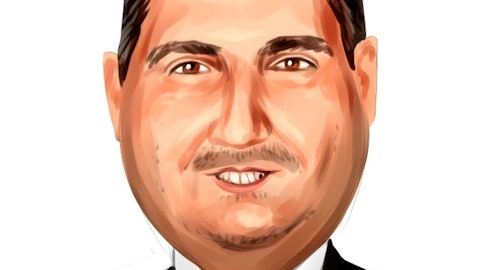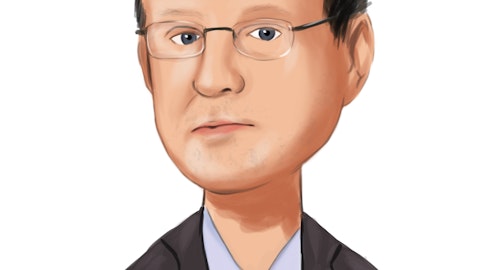Will Jones: Great.
Palmer Proctor: And Will, just to add that, you know, one of the things that we have kind of prided ourselves on, and I give full credit to the mortgage operators, is that the capacity that they’ve created and their ability to lever up that operation is tremendous relative to a lot of our peers. And a lot of that has to do with technology, and certainly, a lot of that has to do with talent. So, when you think about potential tailwinds for the industry or our ability to absorb additional volume in that area relative to our fixed cost, we’re probably in a very good position relative to most others just because we’ve got that infrastructure in place and we have that talent in place.
Will Jones: Yes, that’s great. So certainly, more desirable to be on the offensive there. And then, just one quick one for me on credit. You know, the trends that were broadly clean, we even saw, you know, takedown and criticize or — a takedown and criticize NPAs, although you guys did build the office reserve. I know office is a little bit bigger for you guys, just relatively speaking. What were some of the drivers there? What were some of the dynamics behind that reserve build?
Palmer Proctor: Well, I think you’ll see if you look at the metrics on office right now, knock on, well, we have zero delinquencies and zero charge-offs, and it’s pristine. And so, ours is model driven, as I said in my initial comments. So when we run our models and Moody’s model, and we look at the CRE index and office in particular, that’s really what’s driving that. So, there’s no signs at this stage of any credit deterioration.
Will Jones: Okay, that’s great. Thank you.
Operator: The next question comes from Russell Gunther from Stephens. Please go ahead.
Russell Gunther: Hey, good morning, guys.
Nicole Stokes: Good morning.
Russell Gunther: Circling back to the margin discussion you guys mentioned in the deck, could you quantify about $10 billion of loans repricing within the year, either maturities or floating rate? Just kind of focus on the more fixed piece and what the magnitude coming due is and what you’d expect the pickup in yield potential to be.
Nicole Stokes: Sure. So when we look at it from a repricing perspective, we’ve got about 36%, 37% of our loans that are repricing in the next year. Those are coming in at about a 7.50% rate. So, think about — the thing is, there’s a — so much of our portfolio is — or there’s a portion of the fixed rate portfolio that behaves like a variable rate loan. For example, our premium finance, those have just about a 10-month duration, but they are technically fixed rate, but they behave like a variable rate. So those have really already repriced. So there’s not as much emphasis from a credit score perspective that all of a sudden we’ve got a credit issue of people repricing. And then from the — we also have the warehouse lines that are fixed rate, but they behave like a variable rate. So when you put that in, we’re really more of a 50% fixed, 50% variable.
Russell Gunther: Okay, got it. Thanks, Nicole. And then, maybe just moving on to the capital discussion. When you’re in a very healthy position, excess capital bought back a little stock this quarter. How are you thinking about deployment priorities? And does a more active stance on the buyback, something you’d consider in ’24?
Palmer Proctor: Yes. At this stage of the game, I don’t see any change in our approach there. We’re very pleased with the capital we’ve been able to accrete, and we certainly have the buybacks in our quiver in terms of our ability to execute on that. But right now, we’re kind of just in a capital preservation mode as we work through this economic cycle.
Russell Gunther: Okay, great. Thank you, Palmer. And then, last one for me. You guys touched on the reserve a bit, perhaps related to office. Overall, just a really steady build above peer ratio. Where do you expect this to trend going forward? And then separate, just kind of follow-up would be helpful to get charge-off activity within Balboa and whether there’s any change in that outlook as a part of ’24.
Doug Strange: Well, so with respect to the reserve, as Palmer noted, you know, we are model driven. Our models are based on indices that we think are relevant given our portfolio — our loan portfolio composition. And you know, we’re happy 1% to 1.55% based on the Moody’s forecasting as of March. Any future reserve changes would be — would be led by those models. Second part of your question, charge-offs, we’re 25 basis points for the quarter, which was a little bit better than fourth quarter last year. The charge-offs for equipment finance do remain a little elevated, but you got to remember that’s a high yield, higher risk business. And so, we expect some of that notwithstanding, we did take several steps in tightening up certain credit boxes with respect to that division, but recognizing we get good yields out of that loan business.
Russell Gunther: Yes. No, understood. I was just curious if you had the actual charge-off impacts for the quarter and a reminder on sort of what the lifetime loss you expect range within that — within that book.
Doug Strange: If you look over, you know, 10-year history, the loss rate for equipment, finances, probably sub-2, 1.5 in that range. Are you asking about this quarter in terms of a dollar amount or percentage or what was only a…
Russell Gunther: Yes. I’m just trying to get a sense of the 25-basis point kind of all-in number what Balboa’s contribution was for this quarter.
Doug Strange: The bulk of that — probably 90% of that was equipment finance.
Russell Gunther: Got it. Okay, great. Thank you all for taking my questions.
Operator: The next question comes from Christopher Marinac from Janney Montgomery Scott. Please go ahead.
Christopher Marinac: Thanks. Good morning, Nicole. I wanted to try to connect the dots with the net interest margin possibly bottoming sooner versus later, and then kind of what that means going forward to the PPNR ROA. Could you see that profitability get even stronger as margin, you know, possibly gets better?
Nicole Stokes: You know, Christopher — Chris, we’ve said from the beginning that kind of, if we could come out of this cycle with a 3.50% margin, that we would consider that a victory. And to be at 3.51% this late at the cycle, we feel like that is fantastic. And I say that if we have some short-term compressions at kind of low-single-digit in the next quarter, you know, I think I’ve said last quarter that we had maybe two more quarters, which would have been this quarter and next quarter. So if we are bouncing around between a 3.48%, 3.49%, 3.51%, maybe a 3.52%, you know, somewhere in that range, that’s still a really — that is a really strong margin that we’re pleased with. You know, I’m probably the most cautious person to ever call a trough, but I will say that we like the 3.50-ish margin, and we’re proud of that.





